Sweden is a large country in northern Europe. It is one of Europe’s biggest countries in area, but also one of the most thinly populated. Forests cover more than half the land. The northernmost part of Sweden lies inside the Arctic Circle. This part of the country is sometimes called the Land of the Midnight Sun because, at the height of the summer, the sun never sets. It is the ancient home of the Sami people, formerly known, to outsiders, as Lapps.
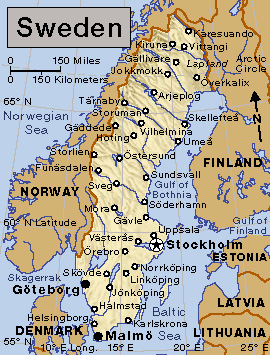
Sweden is also a land of beautiful lakes, snow-capped mountains, swift rivers, and rocky offshore islands. Part of its long coastline has sandy beaches, and other parts have rocky cliffs. Stockholm is Sweden’s capital and most populous city. It lies on the east coast of Sweden, on the Baltic Sea, and it includes small offshore islands.
Sweden and its neighbor Norway occupy the Scandinavian Peninsula. Sweden, Norway, and Denmark are called the Scandinavian countries. The nations have close cultural, economic, historical, language, and religious ties.

The Swedish standard of living ranks among the highest in the world. Many Swedish families spend their weekends and vacations at their small country homes, often on islands or on the shores of lakes and rivers.
Sweden’s way of life has often been called the “middle way,” because it combines private enterprise with some government ownership of industry. Also, the Swedish government offers extensive social security benefits. It provides free education and largely free medical service. It pays pensions to retired people, widows, and orphans. The government also provides health insurance and financial aid for housing. Since the 1990’s, however, Sweden has begun to offer optional private health care. It has also cut back social benefits, such as sick leave and unemployment compensation. Sweden made these changes because an aging population and some slowing of economic growth have strained the system. In addition, the Swedish monetary unit, the krona (crown), has lost value.
Government
National government.
Sweden is a constitutional monarchy with a king or queen, a prime minister and Cabinet, and a parliament. The country had the same constitution from 1809 to 1975, when a new constitution went into effect. The 1809 constitution gave the king _executive power—_that is, the power to put laws into effect. The constitution divided lawmaking power between the king and parliament, called the Riksdag. The Riksdag gradually gained strength, and parliamentary rule was established in 1917. Under the 1975 constitution, the king lost his remaining powers. However, he remained head of state, a position that involved mainly formal and ceremonial duties. In 1980, a constitutional change made the royal couple’s oldest child—male or female—heir to the throne. Today, the monarch formally opens the sessions of the Riksdag. The monarch also must be present at the meeting at which a departing prime minister turns over the government to the new prime minister.
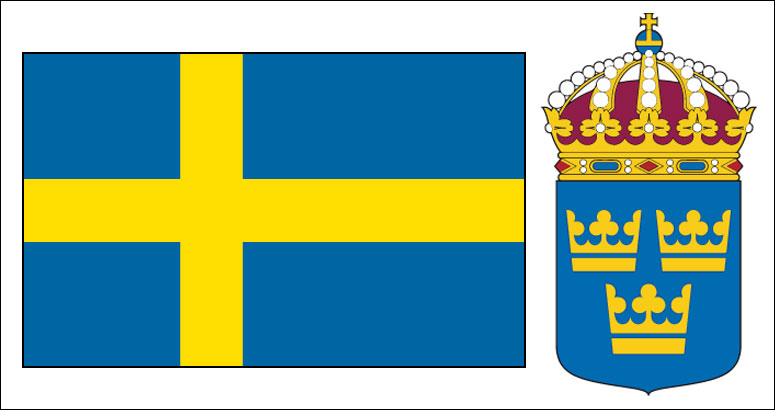
Executive power lies with the prime minister and other members of the Cabinet. The prime minister is nominated by the speaker of the Riksdag and must be confirmed by its members. The prime minister is usually the leader of the largest political party in parliament or the leader of a coalition (combination of political parties) that includes a majority of the Riksdag members. On rare occasions, the leader of a smaller party or a minority coalition has served as prime minister.
The prime minister appoints Cabinet members. Ministries and central administrative agencies, which are made up partly of civil servants, carry out the work of the government. The Riksdag debates and votes on laws proposed by the Cabinet. The Riksdag has the power to remove the entire Cabinet or an individual Cabinet member through a parliamentary motion called a vote of no confidence.
Loading the player...Sweden's national anthem
The Riksdag is a one-house legislature. It has 349 members, who are elected for four-year terms. Voters choose 310 of the members of the Riksdag by voting for political parties in their local electoral districts. The remaining 39 seats are distributed among the parties according to each party’s proportion of the nationwide vote. A party must win at least 4 percent of the nationwide vote, or 12 percent in any district, to receive seats. All Swedish citizens 18 years and older may vote.
Ombudsmen and ombudswomen.
The Riksdag appoints officials called ombudsmen or ombudswomen to protect the rights of citizens in their dealings with government officials or agencies. Specialized ombudsmen offices represent citizens in such matters as consumer affairs, equal opportunity in work, and ethnic discrimination. A special committee appoints an ombudsman for the press.
The ombudsmen, who are assisted by expert staffs, may either begin their own investigations or respond to the complaints of citizens. Sweden created the office of ombudsman in 1809 to help ensure that judges, civil servants, and military officers observed the laws. Sweden was the first country to have an ombudsman.
Politics.
The Swedish Social Democratic Party has long ranked as Sweden’s largest political party. This socialist party helped establish the country’s welfare system. The Moderate Party, a nonsocialist party, and the right-wing Sweden Democrats are also large political parties in Sweden. The country’s other parties include the Centre Party, the Green Party, and the Liberals.
Local government.
Sweden is divided into 21 counties. Each county is administered by a governor appointed by the national government and a council elected by the people.
Courts.
District courts serve the towns and counties of Sweden. Regional courts of appeal hear appeals from the district courts. The Supreme Court is the highest court in the country. This court hears final appeals in important civil and criminal cases.
Armed forces.
Sweden has an army, navy, and air force. Swedish troops have long contributed to United Nations peacekeeping efforts.
People
Most of Sweden’s people live in urban areas, which lie mainly in the central and southern parts of the country. Sweden’s three largest cities by population are Stockholm, Göteborg, and Malmö. Other major cities include Linköping, Örebro, Uppsala, and Västerås.
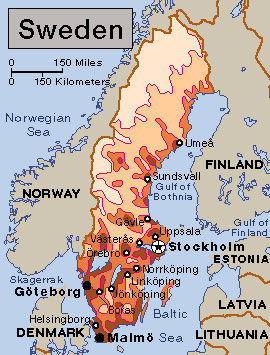
Ancestry.
Most Swedes are descendants of ancient Germanic tribes who settled in the Scandinavian region beginning in 8000 to 5000 B.C. They are thus closely related to the Danes and Norwegians.
Many of Sweden’s people are of Finnish origin. Most of them live in the northern part of the country or along the eastern coast.
The Sami are another large ethnic group in Sweden. They live in the northernmost part of the country, known as Sapmi or Lapland. For thousands of years, the Sami earned a living by hunting, fishing, and tending herds of reindeer. Some Sami continue to move with their reindeer herds from summer pastures to winter pastures, though most of the Sami now have permanent residences. Their other economic activities include the production of artwork, handicrafts, and textiles (see Sami).
A large number of people from other countries have settled in Sweden. During the 1960’s, people from Denmark, Finland, Greece, Norway, Turkey, and Yugoslavia moved to Sweden to find jobs. Since the late 1980’s, many people have immigrated to Sweden from the Balkan region in southeastern Europe and other areas of conflict around the world, such as Afghanistan, Iran, Iraq, and Syria.
Language.
Swedish is a Germanic language that closely resembles Danish and Norwegian. People from Sweden, Denmark, and Norway can usually understand one another.
Spoken and written Swedish are similar throughout the country, but some regional dialects exist. Some Swedes of Finnish origin speak Finnish as their first language but learn Swedish at an early age in school. The Sami speak a language that is related to Finnish. The majority of adult Swedes speak some English. Many speak another foreign language as well.
Way of life
Sweden is a land of striking physical and visual contrasts. Although it has many large cities, it also has countless lakes and vast stretches of forests scattered with villages and towns.
City life.
Sweden’s cities are modern and efficient. They feature blends of traditional and modern architecture. Many Swedish cities, especially Stockholm and Kalmar on the southeastern coast, have imposing castles and churches. Suburbs of the larger cities have high-rise apartment buildings, many built during the 1950’s and 1960’s in response to the rapid growth of cities.
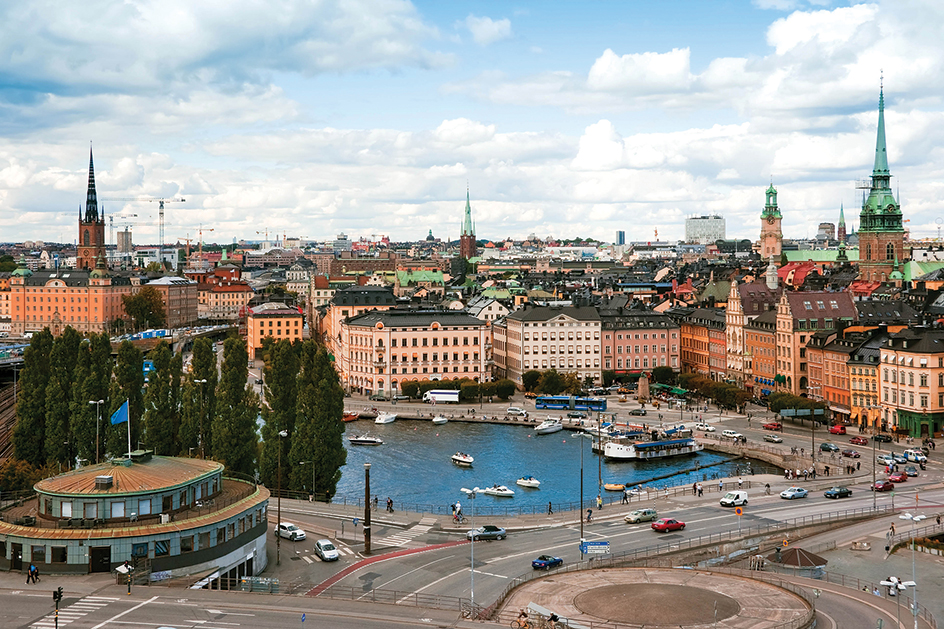
Highways and public transportation facilities, such as railways and buses, link Sweden’s city centers and suburbs. Stockholm has a sprawling subway system. As in other industrialized nations, highway congestion presents a challenge for people who work and live in Sweden’s cities. However, because Sweden relies heavily on electrical energy for heating and industry, pollution is less of a problem there than in many other countries.
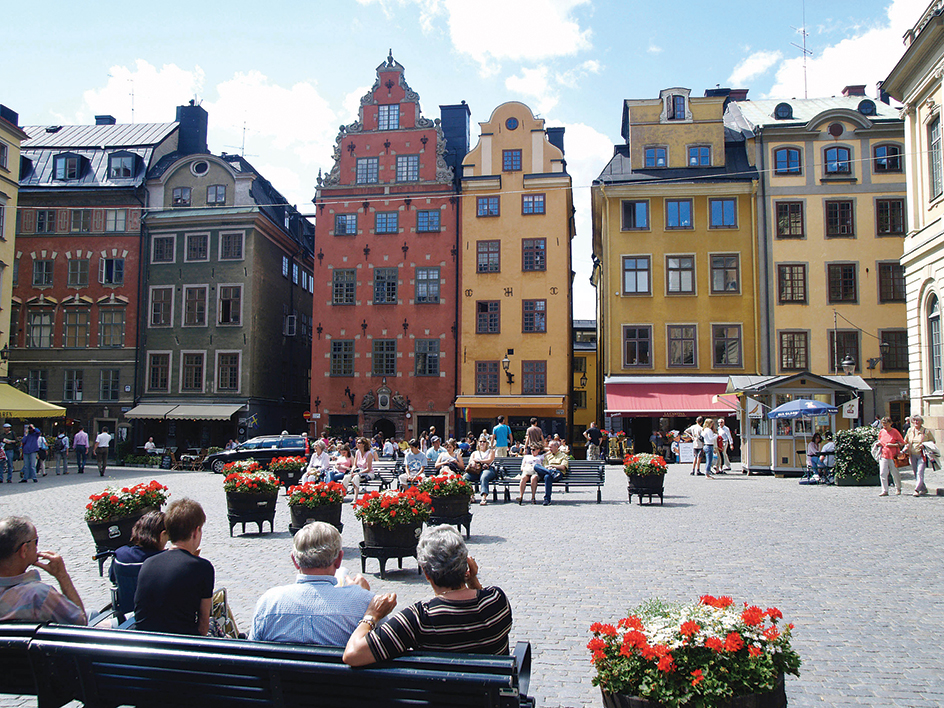
Rural life.
Economic and social development in Sweden have lessened the economic differences between urban and rural residents. The government provides special payments and other supports to farmers, and many rural citizens work in nearby towns. In addition, many people who live in rural areas work part-time on farms and part-time in factories. As a result, people in rural areas maintain a standard of living similar to that of urban dwellers.

Food and drink.
Sweden is famous for smörgåsbord, an assortment of cold and hot foods placed on a large table for self-service. Smörgåsbord is served on holidays, in fine restaurants, and on board many Swedish cruise ships. Many smörgåsbords begin with fish dishes, including anchovies, eels, herring, salmon, sardines, and shrimp. Next come cold meats, such as sliced beef, ham and vegetable salad, liver pâté, and smoked reindeer. Hot dishes—including herring cooked in breadcrumbs, meatballs, omelets, or sausages—follow. Desserts include cheese, fruit, and pastry. Cloudberries are a popular favorite.
Swedes, like their Scandinavian neighbors, drink vast quantities of coffee at mealtime and during breaks from work. Many Swedes also enjoy beer, which is sometimes accompanied by a strong, colorless liquor known as aquavit. They also drink vodka, wine, and other alcoholic beverages. Arak punch is popular among university students.
Religion.
Most Swedes are members of the Lutheran Church. In fact, Lutheranism was Sweden’s official religion from the 1500’s until 2000. Other religious groups include Baptists, Jews, the Mission Covenant Church, Pentecostals, and Roman Catholics. Many immigrants are Eastern Orthodox or Muslim.
The churches pioneered much welfare work in the country, but the government has taken over most of this work. Swedish churches have a long tradition of missionary activities, particularly in Africa, China, and India.
Education.
The Swedish public school system is divided into compulsory (required) and noncompulsory schooling. Compulsory schooling includes regular compulsory school, Sami school, special school, and programs for pupils with learning disabilities. Noncompulsory schooling includes preschool, upper secondary school, upper secondary school for pupils with learning disadvantages, municipal adult education, and education for adults with learning disadvantages. The public school system is free.
The compulsory school program is for children between the ages of 7 and 16. Almost all compulsory school students continue on to upper secondary school. There are 18 national upper secondary programs, which last three years. The programs consist of nine core subjects, program-specific subjects, and a special project. Programs range from business and arts to science and technical subjects. The programs prepare students for further studies, vocational training, or a combination of the two. Students may enroll in a regular upper secondary school until age 20. After that, adult learners may take part in various forms of adult education organized by many different operators. Adult education includes basic and upper secondary education, as well as continuing education programs.
Sweden has a number of universities and other institutions of higher education. The oldest, Uppsala University, was founded in 1477. Göteborg, Linköping, Stockholm, and Umeå universities also rank among the country’s finest.
Libraries and museums.
Sweden’s general research libraries include the Royal Library in Stockholm and the university libraries in Göteborg, Lund, and Uppsala. The Royal Library, established in the 1600’s, has a large collection of early Swedish manuscripts. Sweden also has hundreds of public libraries. 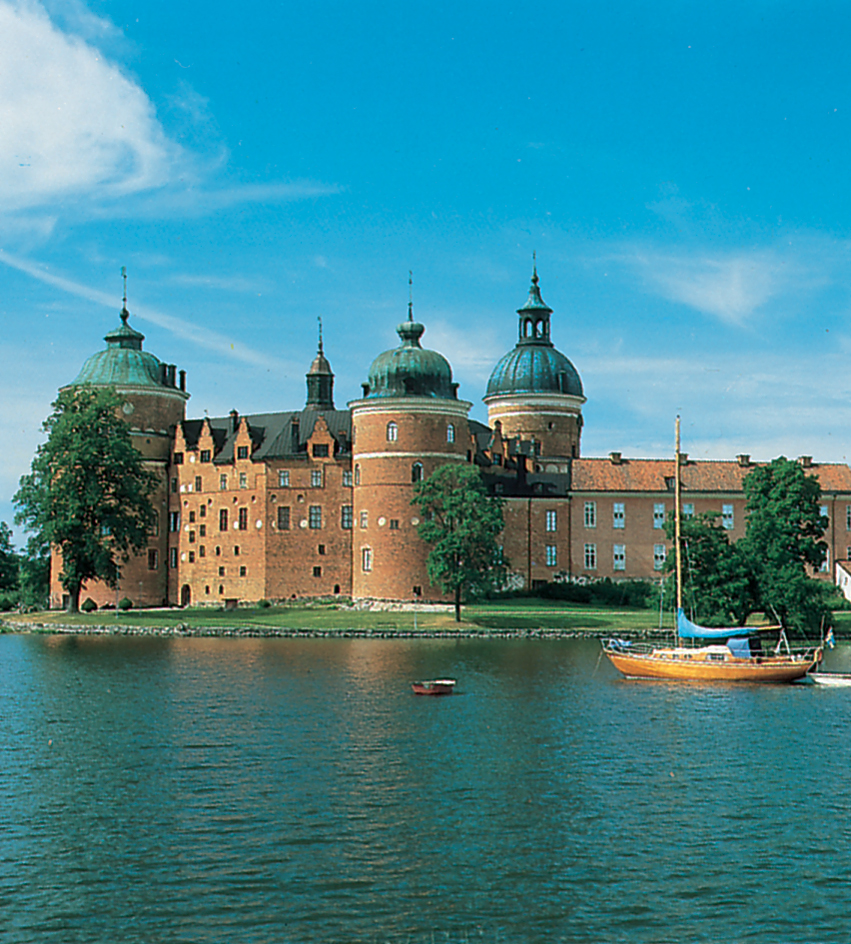
The country’s leading museums include Skansen, an outdoor museum where old Swedish houses re-create historic villages. The National Museum has Sweden’s most important collection of sculpture and paintings. Both museums are in Stockholm.
Recreation.
Outdoor activities—particularly winter sports, such as skiing and hockey—are popular in Sweden. Every March, thousands of Swedes take part in a cross-country ski race called the Vasaloppet, held in the county of Dalarna in central Sweden. The race covers about 55 miles (89 kilometers). Hunting and fishing are also popular activities. Game animals include deer, fox, moose, and various wild fowl. Game fish include pike, salmon, and trout. Long distance ice-skating, using long blades, is also popular. 
Bicycling, camping, hiking, sailing, soccer, swimming, and tennis are all popular in Sweden. A number of Swedes, including Björn Borg and Stefan Edberg, became international tennis stars. Annika Sorenstam ranked as one of the leading woman golfers.
Many Swedes spend their vacations by the sea or on the country’s offshore islands, such as Gotland or Öland in the Baltic Sea. Others relax near one of Sweden’s many lakes or in the vast wilderness that covers the northern part of the country. Tourists enjoy three-day trips along the Göta Canal, which flows across southern Sweden. This canal links lakes and rivers, making a trip of about 350 miles (560 kilometers) from Göteborg to Stockholm. During summer in the cities, people enjoy Sweden’s many urban parks, or sip coffee and watch passers-by at sidewalk cafes. 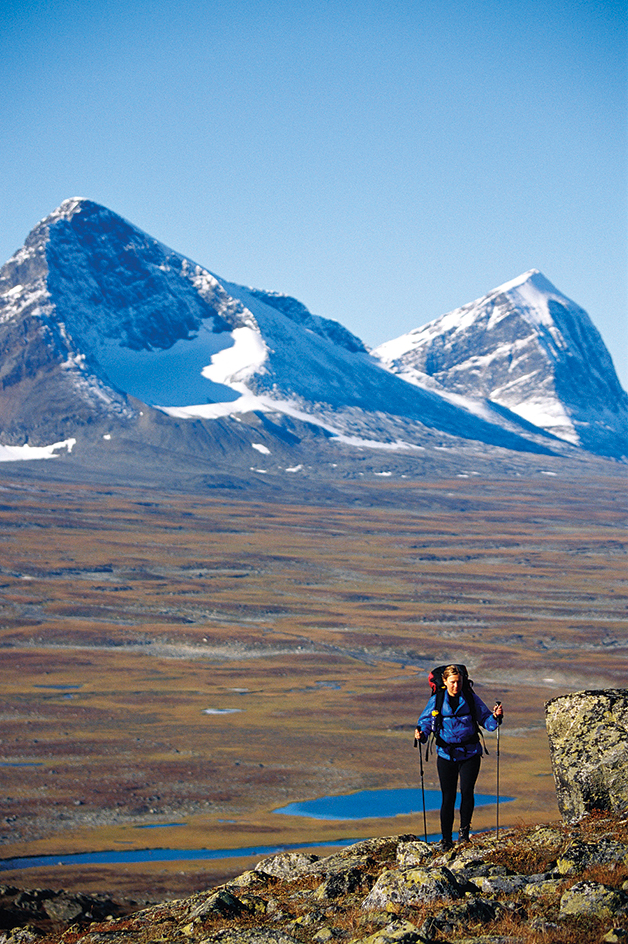
Holidays.
The major winter festivals in Sweden take place in December. On December 13, Swedish families celebrate Luciadagen (St. Lucia Day), the Festival of Light. At home, a daughter of the family traditionally plays Lucy. She gets up early and dresses in white with a crown of leaves. She carries candles or wears some in her crown. The family celebrates the morning with a breakfast that typically includes hot coffee and special saffron buns.
Swedes have their Christmas celebration late on Christmas Eve. Families gather for dinner, which usually includes ham and a fish course. After dinner, family members exchange presents.
May Day is an important holiday for high school graduates and university students. June has a number of special days in Sweden. Midsummer’s Eve and Midsummer’s Day festivities are held on the Friday and Saturday between June 19 and 26. To celebrate Midsummer’s Eve, many people stay up most of the night and dance around gaily decorated Maypoles. Flag Day, the national holiday, is June 6. The monarch presents the national flag to Swedish organizations and societies at a special ceremony. 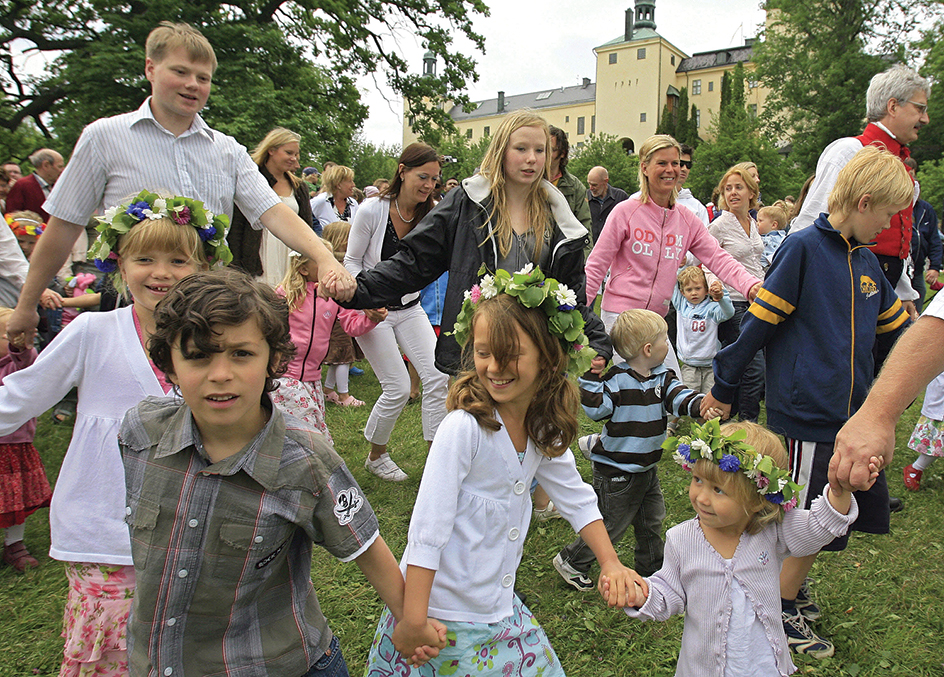
Social welfare.
The Swedes pay high taxes, but the government provides extensive welfare benefits. Every family receives an allowance for each child under 16. The government also provides housing allowances for families with children. The allowance is based on family income, the number of children, and the cost of housing. Every employed person is guaranteed a five-week annual vacation with pay.
Swedes who lose their jobs receive unemployment benefits representing about 80 percent of their former earnings. The people have largely free medical service, although private health care is also available. After retirement, most Swedes receive annual pensions of about 65 percent of their average earnings during their 15 highest paid years. The government also provides pensions for widows, orphans, and children who have lost one parent.
Arts
Literature.
One of the earliest works in Swedish was a rhymed epic called the Erik Chronicle (about 1330), which tells the story of the Swedish duke Erik Magnusson. The Swedish scholar Olaus Magnus achieved international literary acclaim with his History of the Northern Peoples, published in Latin in 1555.
Olaus (also called Olof) Rudbeck, a professor of medicine at Uppsala University, wrote the four-volume epic Atlantica (1679-1702). It tries to prove that Sweden was the cradle of civilization. In the early 1800’s, Erik Johan Stagnelius wrote Romantic poetry portraying the struggle between the desires of the body and the soul. In the mid-1800’s, Carl Jonas Almqvist wrote realistic novels and short stories about love and marriage.
August Strindberg became the most influential Swedish writer of the late 1800’s and early 1900’s. Strindberg’s play Miss Julie (1889) depicts a privileged young woman who is attracted to her father’s servant. Strindberg’s shocking subjects and realistic portrayals of human complexity greatly influenced modern drama.
A number of Swedish authors have been honored with Nobel Prizes in literature. In 1909, Selma Lagerlöf became the first Swede to receive the prize. She still ranks as the country’s best-known novelist for her stories about life in her native Värmland. Other Nobel Prize winners were the poets Verner von Heidenstam in 1916 and Eric Axel Karlfeldt in 1931 and the novelist Par Fabian Lagerkvist in 1951. In 1974, Eyvind Johnson and Harry Edmund Martinson shared the prize. Johnson received recognition for his novels and short stories and Martinson for his dramas, essays, novels, and poems. Tomas Tranströmer won the 2011 prize for his poetry.
In the 1960’s and 1970’s, the husband-and-wife team of Maj Sjöwall and Per Wahlöö gained international popularity for their novels about Stockholm policeman Martin Beck. Astrid Lindgren became known for her popular children’s books, including Pippi Longstocking (1945). Lars Gustafsson won attention as a novelist, poet, and social critic. Gustafsson’s five-volume series The Cracks in the Wall (1971-1978) takes the form of notebooks left by a man named Lars, beginning in childhood and ending with his death from cancer. Torgny Lindgren is another of Sweden’s best-known and admired novelists. In the first decade of the 2000’s, Stieg Larsson’s Millennium trilogy became international best sellers. The series of three crime novels were published in English as The Girl with the Dragon Tattoo (2008), The Girl Who Played with Fire (2009), and The Girl Who Kicked the Hornets’ Nest (2010).
Fine arts.
The Vikings, from roughly A.D. 800 to 1100, left splendidly carved stones depicting horses, warriors, and boats throughout Sweden. In the 1400’s, the painter Albertus Pictor became known for his church paintings. 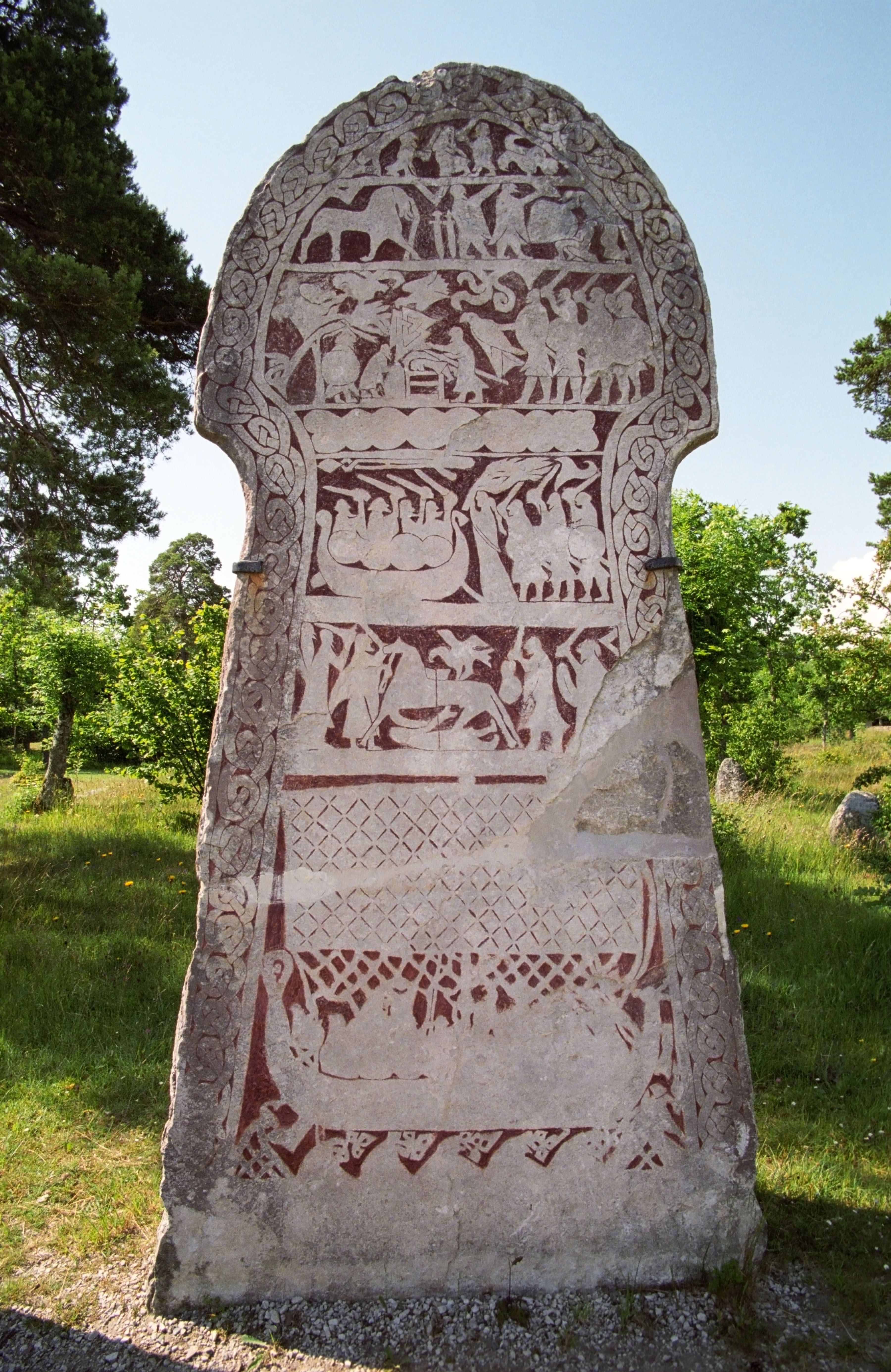
The late 1700’s produced several celebrated Swedish artists, including Alexander Roslin, Carl Gustaf Pilo, and Adolph Ulrik Wertmüller. Two Swedish painters achieved great popularity in the late 1800’s and early 1900’s—Anders Zorn for his landscapes and portraits, and Carl Larsson for his idealized images of family life.
During the early 1900’s, the Swedish sculptor Carl Milles became known for his monuments and sculpture fountains. In architecture, Ragnar Östberg designed Stockholm City Hall, which was completed in 1923. The hall’s design revived several earlier Swedish styles, including palaces of the 1500’s. It influenced architects throughout Scandinavia as part of what became known as the National Romantic movement.
Industrial design.
Sweden, along with other Scandinavian countries, made its greatest contribution to the arts in the field of industrial design. Industrial design is the creation of household objects, automobiles, and other mass-produced products to make them both useful and attractive. Scandinavia became influential in industrial design in the 1920’s and 1930’s. Scandinavian designers created simple, harmonious ceramics, furniture, glassware, and textiles. Swedish furniture designers emphasized light-colored wood and bright upholstery and drapery. Since the 1980’s, the Swedish furniture company IKEA has expanded to many countries throughout the world. 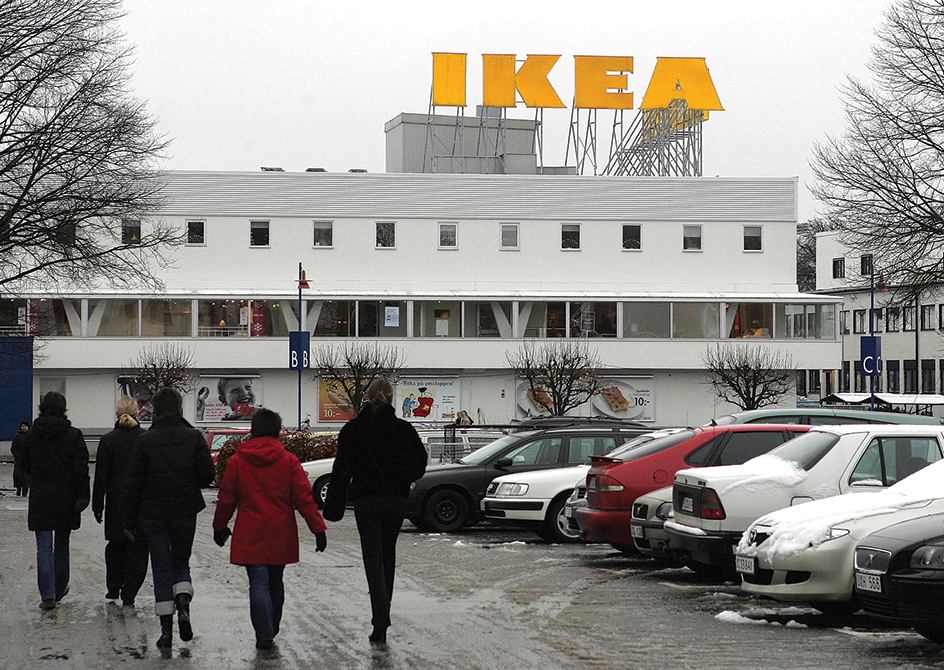
Music.
Sweden has made important contributions to many kinds of music. The country’s folk music tradition dates from at least the 1300’s. The most common Swedish folk instruments include the accordion, the fiddle, and a stringed instrument called the nyckelharpa. Loading the player...
Swedish traditional dance
In classical music, the Swedish soprano Jenny Lind became one of the most famous opera and concert singers of the 1800’s. Tenor Jussi Björling and soprano Birgit Nilsson ranked among the greatest opera singers of the 1900’s.
In popular music, the Swedish quartet ABBA became one of the most successful singing groups of the 1970’s. The musical Mamma Mia! (1999) features many of ABBA’s songs.
Motion pictures.
Sweden developed an important motion-picture industry in the early 1900’s. Victor Sjöström and Mauritz Stiller were two influential directors of the era. Many of their films were based on Scandinavian literature. The famous movie star Greta Garbo began her career in Swedish silent films before moving to the United States in 1925. Ingrid Bergman was another performer who started her career in Sweden and then achieved fame in the United States. The most important figure in Swedish motion pictures was director Ingmar Bergman. He gained worldwide recognition for his symbolic, brilliantly photographed films. Another Swedish director, Lasse Hallström, also achieved international success. 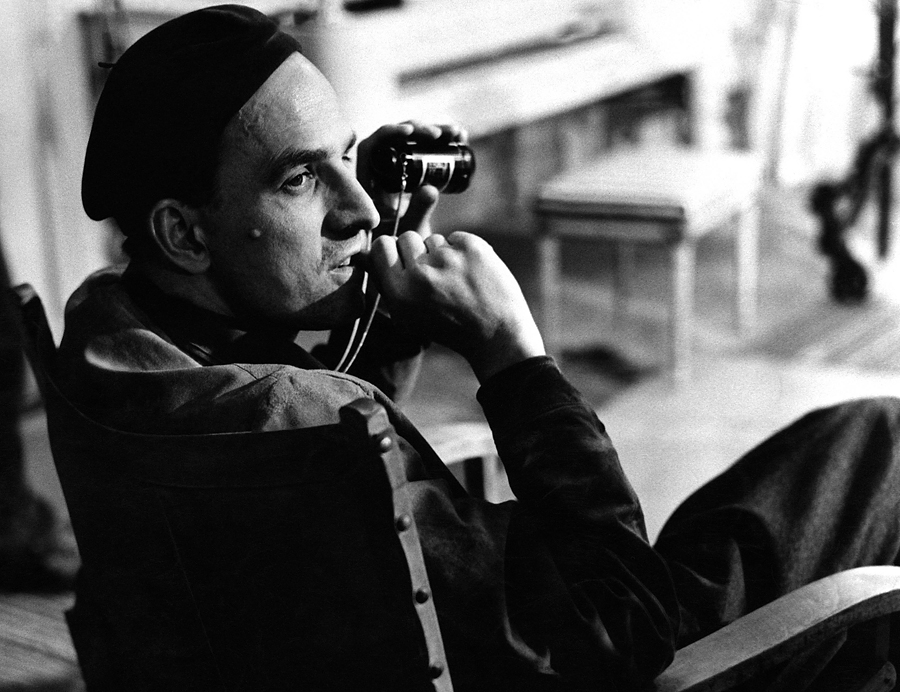
The land
Sweden occupies the eastern part of the Scandinavian Peninsula. Sweden’s border with Norway is hilly and, in parts, mountainous. From there, the land slopes gently south and eastward to the Gulf of Bothnia and the Baltic Sea. Sweden’s scenery varies from the treeless Kölen Mountains in the northwest to the fertile plains in the south. Thousands of lakes cover about a twelfth of the country’s area.
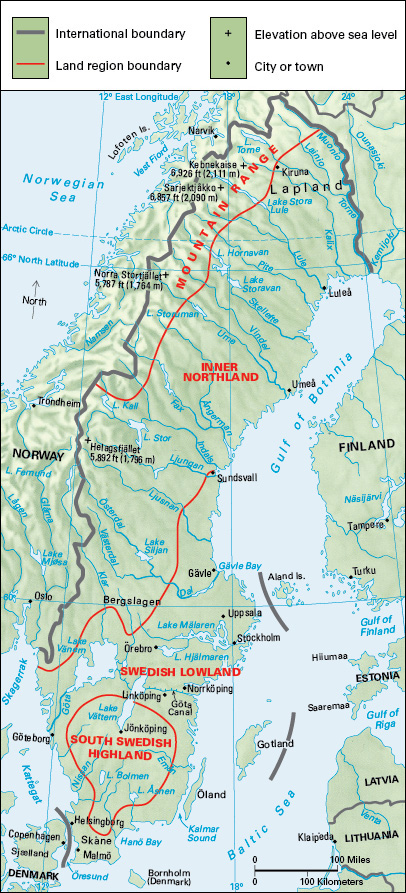
The long coastline of Sweden has sandy beaches in the south and rocky cliffs in parts of the west and north. Many groups of small islands lie off the coast. The largest islands are Gotland, a fertile island covering about 1,160 square miles (3,004 square kilometers), and Öland, which covers about 520 square miles (1,350 square kilometers). Both islands are in the Baltic Sea.
Sweden has four main land regions: (1) the Mountain Range, (2) the Inner Northland, (3) the Swedish Lowland, and (4) the South Swedish Highland.
The Mountain Range
is part of the Kölen Mountains. Sweden’s northern boundary with Norway runs through these mountains, which Norwegians call the Kjølen Mountains. Hundreds of small glaciers cover the higher slopes of the snow-capped range. Sweden’s highest mountain, 6,926-foot (2,111-meter) Mount Kebnekaise, rises in this rugged region.
The land is completely treeless above about 1,600 feet (488 meters) in the northernmost part of the mountains. There, the climate is too cold for trees. Some birch trees grow on the warmer, lower slopes.
The Inner Northland
is a vast, thinly populated, hilly region. Great forests of pine and spruce trees cover most of the land, and lumbering is an important industry. Many swift rivers flow southeast across the Inner Northland and provide hydroelectric power. The rivers have formed deep, narrow valleys, some of which have long lakes. The valleys broaden toward the coast of the Gulf of Bothnia. Most of the region’s people live in these valleys or on the coast.
The Torne River forms part of the boundary between the Inner Northland and Finland. Other waterways in the region include the Angerman, Dal, Lule, and Ume rivers. Bergslagen, a hilly area rich in minerals, lies south of the Dal River in the southern part of the Inner Northland.
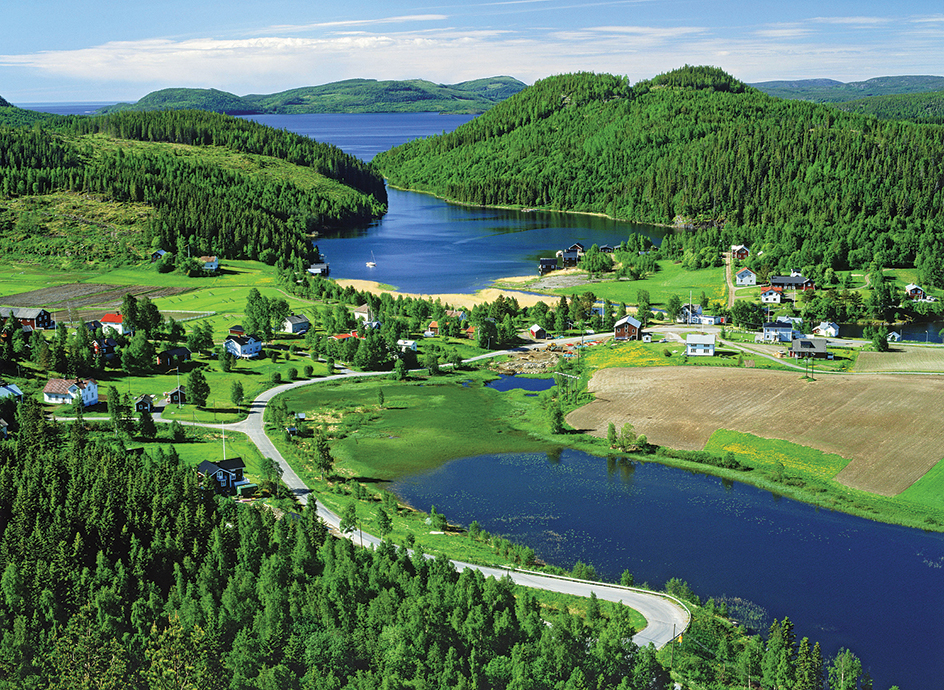
The Swedish Lowland
has more people than any other part of the country. This region includes the central and southern plains of Sweden. Lakes, tree-covered ridges, and small hills dot the broad central plains. Farmland covers more than 40 percent of these plains.
Sweden’s largest lakes, Vänern and Vättern, are in the Swedish Lowland. Lake Vänern covers 2,156 square miles (5,584 square kilometers) and is one of the largest lakes in Europe. Lake Vättern has an area of 738 square miles (1,911 square kilometers).
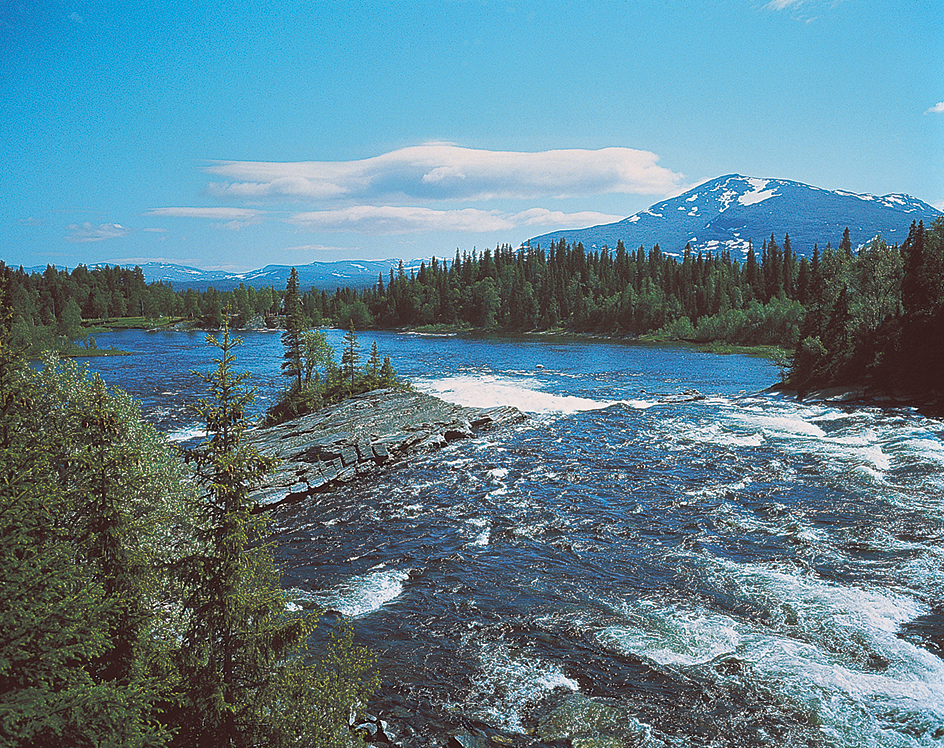
The southern plains include some of Sweden’s most fertile land. Farmland and forests of beechwood cover most of Skåne, which is the southernmost region of the country. Skåne is the most thickly populated and richest farming area of Sweden.
The South Swedish Highland,
also called the Gotaland Plateau, is a rocky upland that rises to about 1,200 feet (366 meters) above sea level. This thinly populated area has poor, stony soils, and is covered mostly by forests. The southern part of the region is flat, with small lakes and swamps.
Climate
The climate of Sweden varies greatly between the southern and northern parts of the country. Southwesterly winds from the Atlantic Ocean give southern Sweden pleasant summers and mostly mild winters. In contrast, the northern part of the country has pleasant summers but cold winters. The Atlantic winds are blocked by the Kölen Mountains, and therefore have less effect on northern Sweden.
Rainfall is generally greater in the Kölen Mountains and the southern highlands than on the plains that border the Gulf of Bothnia. In the south, snow covers the ground in January and February. The north has snow from mid-October through mid-April.
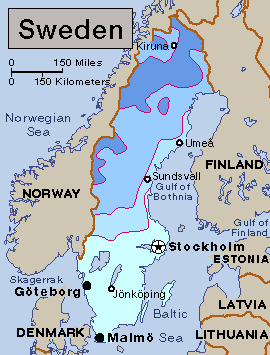
Economy
Sweden is a highly industrialized nation. Its economy is based on a combination of advanced engineering and service industries. It also relies heavily on exports. Most Swedish industry is privately owned. Government ownership is concentrated in energy, mines, and public transportation.

Abundant natural resources, such as vast forests and rich deposits of iron ore, helped change Sweden from a poor agricultural nation to an advanced industrial society. Nuclear power plants, along with hydroelectric power, provide much of the nation’s energy needs. Rich farmland in the southern and central regions of Sweden supplies most of the country’s food.
Close cooperation among government, employer groups, and labor unions helped in bringing about Sweden’s economic development. These groups have sought to promote full employment through a labor policy based on the retraining and relocation of workers who have lost their jobs. In addition, Sweden’s government assisted the country’s economic development indirectly through its industrial and tax policies. The government has invested public funds in research and development to encourage innovation in technology and other fields. The government has also devalued (lowered the value of) the krona at times in an effort to reduce the cost of Swedish exports and thus make them more attractive abroad.
Service industries
account for about four-fifths of Sweden’s jobs and two-thirds of the total value of Sweden’s economic production. Service industries provide services rather than produce goods.
Community, government, and personal services are by far the leading employer among service industries in Sweden. Among the most important of these are education, health care, information and communication technology, and scientific research and development. Hotels, restaurants, and shops benefit from the millions of tourists who visit Sweden each year. Most of these tourists come from Denmark, Germany, Norway, and other European countries.
Manufacturing
industries are scattered along the coast and throughout central Sweden and the western part of Skåne. The iron and steel industry produces high-quality steel, which is used for such products as ball bearings, stainless steel goods for the home, and precision tools. Steel is widely used in the engineering industry, which accounts for about half of Sweden’s industrial production and also for about half of its exports.
Sweden’s important engineering products include agricultural machinery, aircraft, automobiles, and ships. Linköping is the chief center of the country’s aircraft industry, and Trollhättan has aircraft engine and diesel motor plants. Göteborg and Trollhättan have major automobile plants. Many of the automobiles made in Sweden are exported. The electrical engineering industry makes equipment for power plants and communications.
The Swedish chemical industry imports most of its raw materials. The chief products include explosives, pharmaceuticals, plastics, and safety matches. Safety matches can only be ignited on a special lighting surface. They were invented in Sweden in 1844, and the country is still one of the world’s leading producers.
Agriculture.
Farmland covers less than 10 percent of Sweden. Skåne, in the extreme south, has a good climate and is the most fertile area. Other agricultural areas lie in the south and around the lakes in central Sweden. However, much of northern Sweden is too cold and infertile for farming. Less than 1 percent of the Inner Northland region is cultivated. Most Swedish farmers own their own land.
Dairy farming and livestock raising are important sources of income for Swedish farmers. Beef, milk, and pork are the leading livestock products. Chickens are raised for eggs and meat. The chief crops include barley, oats, potatoes, sugar beets, and wheat. Almost all farmers belong to Sweden’s agricultural cooperative movement. Agricultural cooperatives collect, process, and market products produced by their members in an effort to get better prices (see Cooperative).
Mining.
Sweden has some of the richest iron ore deposits in the world. Most of Sweden’s iron ore is found near Kiruna in Lapland. The Lapland mines have some of the world’s best high-grade ores.
Most of the Lapland ore is exported. In summer, the Lapland ore is shipped from the port of Luleå, on the Gulf of Bothnia. In winter, Luleå’s harbor is icebound, and the ore is carried by train across the mountains to the ice-free port of Narvik in Norway.
The Swedish iron and steel industry gets most of its ore from the Lapland mines. The Skellefteå region in northern Sweden has copper, gold, lead, and silver.
Forestry.
Forests cover more than two-thirds of Sweden, and about a tenth of the nation’s exports are lumber or products made from wood. The main lumber regions are in the north and north-central sections, where the most important trees include birch, pine, and spruce. Almost all lumber is carried to sawmills by truck and railroad. Then, it is processed into many products for domestic use and export. Forestry is less important in southern Sweden, even though beech, birch, oak, pine, spruce, and other trees cover large areas.
Fishing.
Herring is the most important fish caught in Swedish waters. Other catches include cod, mackerel, and prawns. Much of the fish catch comes from the Baltic Sea.
International trade.
The value of Sweden’s exports is about the same as the value of its imports. Sweden exports large amounts of paper products and imports almost none. However, the country imports larger amounts of petroleum and farm products than it exports. Sweden both exports and imports various types of chemicals, electrical machinery, and transportation equipment, and other goods. Sweden’s major trading partners include Denmark, Finland, France, Germany, the Netherlands, Norway, the United Kingdom, and the United States.
Transportation.
Sweden has a good railroad network, most of which is owned by the government. Ferries connect Swedish railroads with those in Denmark and Germany. Sweden has a network of good roads and highways, and trucks carry more freight than the railroads do.
The Öresund Link is a bridge and tunnel connection between Malmö, at the southern tip of Sweden, and Copenhagen, Denmark. The link serves railroad trains as well as automobiles.
Stockholm has an international airport at nearby Arlanda. Other important airports serve Göteborg and Malmö. Sweden’s busiest port is Göteborg. Other port cities include Helsingborg, Malmö, and Stockholm.
Communication.
Sweden has dozens of daily newspapers. Important dailies include Aftonbladet, Dagens Nyheter, Expressen, and Svenska Dagbladet, all published in Stockholm, and Göteborgs-Posten, published in Göteborg. Most of Sweden’s newspapers are privately owned. Freedom of the press is guaranteed by law, and government censorship is forbidden even in wartime.
Radio and television stations operate under both private and state ownership. Internet usage and cell phone usage increased sharply in the 1990’s. Smartphone usage became nearly universal during the 2010’s.
History
Early times.
Sweden was one of the last regions to lose the ice that covered most of Europe thousands of years ago. The ice had melted from the southern tip of Sweden by about 8000 B.C., and groups of people that hunted and fished began to move from south of the Baltic Sea into this region. People settled farther north as the climate improved. Bronze was introduced about 1500 B.C., and iron was widely used by 500 B.C.
Beginning about 50 B.C., the people traded with the Roman Empire. They exchanged furs and amber for glass and bronze objects and silver coins. The Romans were the first people to make written records about the Swedes. About A.D. 100, the Roman historian Tacitus wrote about the Svear, a Scandinavian people. Sverige (Sweden) means land of the Svear.
The Swedish Vikings.
Beginning about A.D. 800, Scandinavian adventurers called Vikings sailed to many parts of the world. They acquired wealth by trade and conquest. Most Norwegian and Danish Vikings sailed westward, but many Swedish Vikings traveled eastward across Russia, as far as the Black and Caspian seas. There, the Swedes founded the Rurik dynasty, which ruled Russia for hundreds of years. They traded slaves and furs for gold, silver, and luxury goods. The Viking expeditions lasted until the 1000’s. Much of Sweden’s trade with the east then fell to German merchants, who settled in the town of Visby on the island of Gotland.
The early kingdom.
Saint Ansgar, a Frankish monk, preached Christianity in Sweden in A.D. 829. His missionary work began a struggle between Christianity and earlier religious traditions. The struggle lasted about 200 years. The first Christian king of Sweden was Olof Skötkonung, who ruled from the late 900’s to the early 1000’s. Christianity brought about great changes in Sweden. The clergy founded schools, encouraged the arts, and set down Sweden’s laws in writing.
By the 1000’s, Sweden, Denmark, and Norway had become separate kingdoms. Sweden’s king was elected by provincial lawmaking assemblies. In 1249, Sweden conquered much of Finland.
Union with Norway and Denmark.
During the 1200’s and 1300’s, constant struggles took place between the rulers of Sweden and the nobles. In 1388, to oppose the growing German influence in Sweden’s affairs, the nobles turned for help to Queen Margaret of Denmark and Norway. The Scandinavian countries defeated the Germans in 1389. Denmark, Norway, and Sweden then united under Margaret in 1397. A treaty called the Union of Kalmar laid down the conditions of the union between the three countries. This treaty provided for a common foreign policy but separate national councils. It also called for the continuation of existing laws in each country. Except for a few short periods of separation, the union lasted more than 100 years.
Sweden’s economy grew during the 1200’s and early 1300’s under the influence of German merchants. The merchants developed Sweden’s mineral resources and took over much of the country’s trade. Plague wiped out a large part of Sweden’s population in 1350 and caused an economic decline. The German merchants, who had a powerful trading alliance called the Hanseatic League, increased their control over Swedish trade (see Hanseatic League).
The beginnings of modern Sweden.
The union with Norway and Denmark continued throughout most of the 1400’s. But many struggles took place between supporters and opponents of the union. Gustavus Vasa, a Swedish noble, finally broke away from the union in 1523 after defeating the Danes. He became King Gustav I Vasa, the first king of independent Sweden, that year. Norway remained under Danish rule.
Gustav laid the foundations of the modern Swedish state. He centralized the administration of government, dealt harshly with revolts, and built an efficient army. He encouraged trade and industry, and he ended the monopoly over Swedish trade held by the Hanseatic League. Gustav increased the power of the king but also expanded parliament to represent more of the people. In 1527, he held the first parliamentary meeting that included representatives of four social classes: (1) the nobles, (2) the clergy, (3) the townspeople, such as merchants, and (4) the peasants. By the 1540’s, parliament was called the Riksdag.
Gustav sought to reduce the political and financial power of the Roman Catholic Church in Sweden. He encouraged the followers of Martin Luther, the German religious reformer, to spread their ideas. Lutheranism became Sweden’s official state religion.
The age of expansion.
Beginning in the late 1500’s, the Swedes fought a series of wars to gain control of the lands surrounding the Baltic Sea. King Gustavus Adolphus, also known as Gustav II Adolf, won many victories for Sweden and the Protestant side in the Thirty Years’ War (1618-1648). Sweden gained new possessions in Europe, and these gains led to continual wars against Denmark, Poland, and Russia. Between 1617 and 1648, military victories over Denmark, Poland, and Russia gave Sweden territories on both sides of the Baltic Sea, as well as some areas in what are now Germany and Poland. In 1658, under the Treaty of Roskilde, the Swedes forced the Danes to give up the province of Skåne (also spelled Scania) on the Swedish mainland. 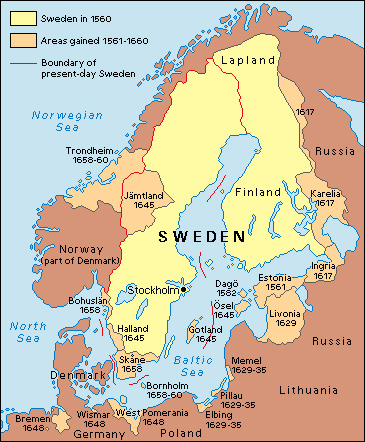
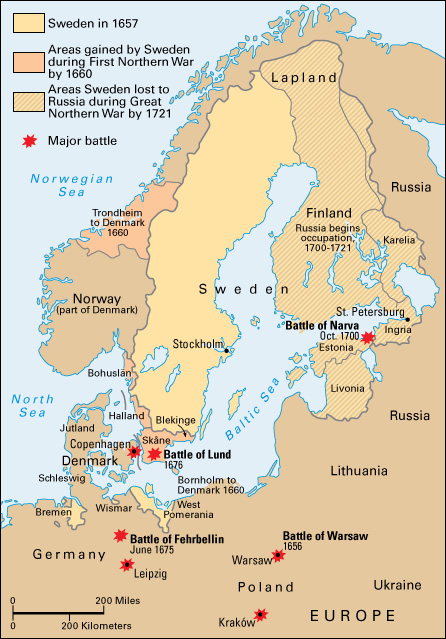
Charles XII, who ruled from 1697 to 1718, won many victories during the first half of his reign, making Sweden one of the greatest powers in Europe for a time. In 1709, however, Czar Peter the Great of Russia defeated the Swedes in the Battle of Poltava. During the next few years, Sweden was forced to give up most of its European possessions, including its Baltic provinces and Bremen and Verden in Germany.
The Age of Liberty.
Charles XII died in 1718. Before agreeing to elect a new king, the Riksdag insisted that any monarch chosen should accept a new constitution. This Constitution, which was passed in 1720, transferred many of the crown’s powers to the Riksdag. The period of parliamentary government that followed was called the Age of Liberty and lasted until 1772. That year, an unsuccessful war in Germany and serious economic and political troubles at home resulted in a peaceful revolution that reestablished the power of the king.
The Napoleonic Wars.
Because of its growing trade with the United Kingdom, Sweden became involved in wars against the French emperor Napoleon in the early 1800’s. As a result of these wars, Sweden lost Finland to Russia but gained Norway from Denmark. In 1809, Sweden adopted a new constitution.
In 1810, the Swedish Riksdag elected Jean Baptiste Jules Bernadotte, a French army officer, to be the heir of King Charles XIII, who was childless. In 1818, Bernadotte succeeded to the Swedish throne as Charles XIV John. Sweden’s present royal family is descended from him.
Emigration.
During the 1800’s, Sweden brought more land into use for farming. However, the population increased so much that food was often in short supply. There were not enough jobs, and nearly 450,000 people left Sweden between 1867 and 1886. Most of them moved to the United States and settled mainly in the upper Midwest.
Growth of industry.
The building of the Göta Canal, linking Sweden’s North Sea and Baltic coasts, helped develop industry and commerce. Engineers built many railroads in the 1860’s and 1870’s, and Sweden’s lumber resources were put into use. In 1867, Alfred Nobel, a Swedish chemist, patented dynamite. The availability of dynamite accelerated the growth of mining. Industries based on iron and steel soon developed. By 1900, Sweden had become an important industrial nation. 
Period of reform.
The 1800’s and early 1900’s became a period of sweeping political and social reform in Sweden. Workers formed labor unions and demanded higher wages, shorter workdays, and workers’ compensation (payments for injuries suffered on the job). Many strikes broke out as employees demanded improved work conditions. Workers also sought the right to vote—a privilege previously granted only to those with a certain level of income. The Swedish Social Democratic Party formed in 1889 on the strength of the Swedish labor movement.
The Swedish government responded to these movements by passing a series of laws. An 1881 law limited the employment of children in factories. A 1901 law created workers’ compensation insurance. A 1913 law authorized a fund for workers’ old age pensions. In 1909, Sweden provided for proportional representation, which gives a political party a share of the seats in parliament in proportion to its share of the total vote cast. Also in 1909, all adult males gained the right to vote for members of the Riksdag. Women with property had voted in local elections since the mid-1800’s, but women did not gain voting rights equal with men until 1921.
In 1905, Norway broke away from Sweden. The Norwegians elected a king, and Sweden recognized Norway’s independence.
Neutrality.
Sweden was neutral during World War I (1914-1918) and World War II (1939-1945). After Germany conquered Norway in 1940, Sweden let German troops pass through on their way to Norway. Many Swedes opposed this policy, and, as the war slowly turned against Germany, Sweden stopped it in 1943.
Economic growth.
From the end of World War II through the 1960’s, Sweden experienced strong growth and rapid change in its economy. The economy expanded and diversified, with more and more workers taking jobs in the commerce, transportation, and service industries. The number of employees in agriculture, mining, manufacturing, and construction declined.
Close cooperation among government, employer groups, and labor unions helped to make Sweden’s economic growth possible. Sweden’s high standard of living spread to all income groups by means of the government welfare system that developed fully after World War II. However, the system led to inflation and some of the highest rates of taxation in the world. Critics also claimed that the welfare system discouraged individual ambition. Still, most Swedes supported it.
Political changes.
A new constitution took effect in Sweden in 1975. It greatly reduced the power of the king and put more power in the hands of the Riksdag and Cabinet.
In 1976 elections, the party that had long held power, the Swedish Social Democratic Party, was defeated, largely because voters were dissatisfied with the country’s high taxes. Except for a few months in 1936, the Social Democrats had controlled Sweden’s government continuously from 1932 to 1976. Various nonsocialist coalitions governed the country from 1976 until 1982, when the Social Democratic Party regained control.
Swedish Prime Minister Olof Palme was shot and killed by an assassin in 1986. The murder remained unsolved until 2020, when the police closed the case after determining that a man who had died in 2000 was the likely killer. In 1991, a nonsocialist coalition won control of the government, but the Social Democrats returned to power in 1994.
During the early 1990’s, Sweden’s economic performance faltered, and unemployment increased. The government trimmed its budget deficits and enacted measures to help Swedish businesses. By the late 1990’s, these efforts resulted in increased prosperity.
Recent developments.
Sweden joined the European Union (EU) in 1995. In the same year, the Lutheran Church of Sweden agreed to the separation of church and state. The church and the government recognized that the Swedish population had come to include many people from other countries who practiced other faiths. 
In 2003, Sweden’s voters rejected a proposal to replace their nation’s currency, the krona, with the euro, a currency used by most other countries of the European Union. In 2006 elections, a center-right union of political parties led by the Moderate Party won control of parliament. Party leader Fredrik Reinfeldt served as prime minister until 2014, when the Social Democrats returned to power. Stefan Löfven became prime minister.
The COVID-19 pandemic became a public health concern in Sweden in early 2020. Authorities recommended residents follow social distancing and personal hygiene guidelines to limit the spread of the disease. Unlike most of Europe, however, Sweden did not implement stay-at-home orders or close schools, restaurants, and public gathering places. Officials initially won favor for this relaxed approach. However, they later conceded missteps when infection and death rates increased, particularly among nursing home residents. Infection and hospitalization rates declined during the summer. They rose again late in the year, prompting some areas to issue restrictions on restaurants, bars, gyms, and other businesses. In December, Swedish authorities for the first time recommended that commuters wear face masks while traveling on public transit. Vaccines first became available to high-risk populations in late 2020. Most Swedes became eligible for vaccines in the spring and summer of 2021, and infection and death rates decreased. In late 2021 and early 2022, however, the spread of new, more contagious variants of the virus that causes COVID-19 led to additional increases in infection rates. Sweden lifted most of its remaining COVID-19 restrictions by the spring of 2022. By early 2023, more than 23,000 people in Sweden had died from the disease.
Löfven announced his resignation as prime minister in June 2021 after losing a no-confidence vote in parliament. He had been under scrutiny for his government’s handling of housing policy. In July, Löfven won a close vote to return as prime minister. Finance Minister Magdalena Andersson succeeded him as leader of the Social Democrats in November. She became prime minister of Sweden later that month, the first woman to hold the position. However, Andersson resigned the next day, after her government’s budget was rejected in favor of one proposed by the opposition Sweden Democrats and after the Green Party quit the two-party governing coalition in response. Parliament reelected Andersson prime minister in December. She resigned again in September 2022, after her center-left coalition suffered an election defeat. A right-wing coalition including the center-right Moderates and the anti-immigration Sweden Democrats won a narrow victory. Moderate Party leader Ulf Kristersson became prime minister in October.
Russia’s invasion of Ukraine in February 2022 prompted the leaders of Sweden and its neighbor Finland to apply for membership in the North Atlantic Treaty Organization (NATO). In June, both countries received formal invitations to join the military alliance. The governments of all NATO member countries must ratify (approve) a country’s proposed membership before the membership becomes official. Finland officially joined NATO in April 2023. Sweden’s application gained strong support from most NATO countries. However, strained relations between Sweden and NATO members Turkey and Hungary stalled the approval process. In early 2024, Turkey and Hungary finally approved Sweden’s membership. Sweden officially joined NATO in March 2024.
